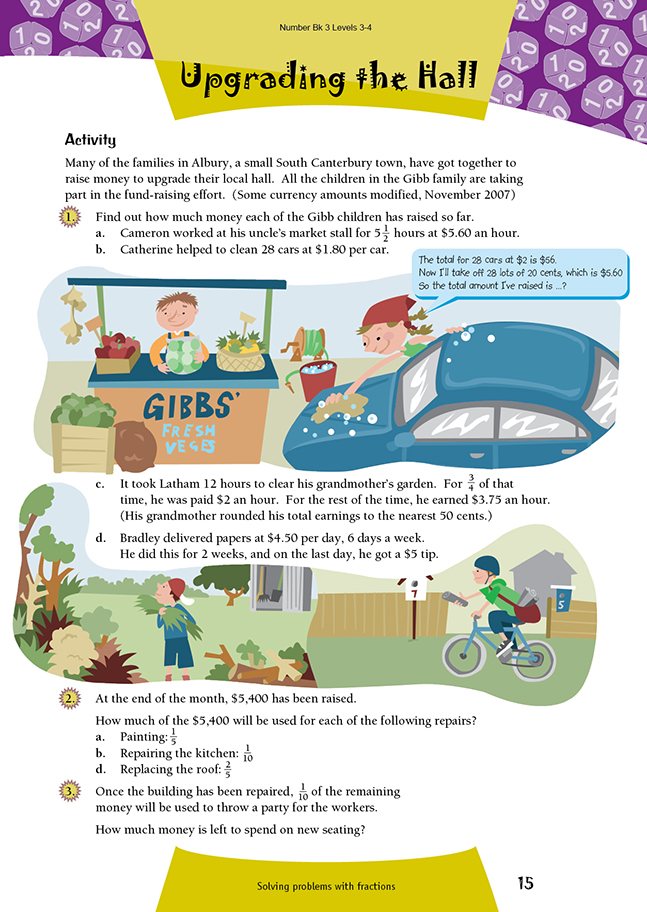This is a level 4 number activity from the Figure It Out series. It relates to Stage 7 of the Number Framework.
A PDF of the student activity is included.
Click on the image to enlarge it. Click again to close. Download PDF (275 KB)
find fractions of money amounts
find fractions of time
FIO, Level 3-4, Number, Book 3, Upgrading the Hall, page 15
Fund-raising is a realistic context that will be familiar to many students. This activity involves finding fractions of amounts or quantities. The multiplicative reasoning required for this makes this activity suitable for students who are advanced additive or beyond.
Most of the questions in this activity can be solved mentally, although the students may need to jot down figures from time to time to assist their memories. They can probably suggest, through discussion, some good mental strategies that they can use.
Cameron’s contribution to the fund-raising can be worked out by calculating (5 x $5) + (5 x 50c) + 1/2 of $5.50. That is, $25.00 + $2.50 + $2.75, which is $30.25. Another strategy is rounding and compensation: (6 x $5 + 6 x 50c) – $2.50 – 25c = $33 – $2.75
= $33 – $3 + 25c
= $30.25
Catherine suggests a strategy in question 1b for working out her contribution. An alternative approach would be to calculate (28 x 1) + 3/4 of 28 (because 75 cents is 3/4 of $1.00, and it is easy to find 3/4 of 28: 1/4 is 7, so 3/4 is 21, found by 3 x 7 or 28 – 7). This amounts to $28 + $21, which is $49.
In Latham’s case (question 1c), the students need to find 3/4 of 12 and multiply that by $2. They could use rounding and compensation to work out the remaining 3 hours: 3 x $4 – 75c.
Bradley’s paper delivering yielded (12 x $4.50) + $5.00, which is $48 + $6 + $5 or $59.00 in total.
Question 2 requires the students to work out some simple fractions relating to the $5,400 raised. They need to be accurate because their calculations on this activity are also critical to solving the problem in question 3. For the painting cost of 1/5, the students can divide the $5,400 by 5 or use doubling: 10 800 ÷ 10. They will probably realise that they simply have to double this amount to calculate the 2/5 cost of replacing the roof. Finding the cost of repairing the kitchen at 1/10 of $5,400 is even simpler: to divide by 10, shift the digits 1 place to the right. The students now need to add $1,080 + $2,160 + $540 before they can work out how much money is left. Encourage them to do this mentally. One strategy is to use compatible numbers: add the $40 to $2,160 to get $2,200, then add the $500 to get $2,700. It should be easy then to add $1,080 to get $3,780. To subtract this total from $5,400, they could rewrite this as a missing addends problem, $3,780 + = $5,400, and solve it using an empty number line:
Solving the problem in question 3 involves calculating 1/10 of $1,620 and subtracting this to work out the amount of money available for new seating.
Answers to Activity
1. a. $30.25
b. $49
c. $29.25
d. $59
2. a. $1,080
b. $540
c. $2,160
3. $1,458

